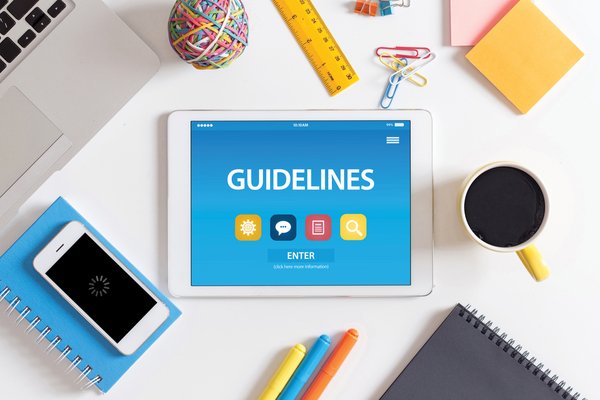This post originally appeared on tBL member Joshua Lyon’s blog Joshua Lyons Marketing Blog and is republished with permission. Find out how to syndicate your content with theBrokerList.

So, you’ve decided to start a business and you are getting a lot of mixed messages from the people who want to see you succeed about what, exactly, needs to be done to launch it properly. It probably seems like everybody has an opinion and it’s quite normal to find yourself questioning everything. At some point in the business building process, you’ve likely heard some of these do-gooders assuring you that you absolutely must create branding guidelines if you want to achieve maximum success. Are they right? Well, yes and no. There are some extremely big perks for creating branding guidelines for your small business. But, jumping headfirst into the process may or may not be in your personal best interest.
What Exactly are Branding Guidelines?
Before you can accurately determine whether or not your small business needs branding guidelines, it’s important to understand what they are. Branding guidelines are protocols created for your business that specify exactly how things should look in order to present the most accurate image of your business. hese guidelines might include the exact colors and sizes of your logo(s), when to use different logos for different things, where logos should appear on various types of marketing materials, and so much more (but we’ll get into that later). Branding guidelines will help you to convey exactly what your business is all about, as well as its goals, mission, audience and overarching vision.
Reasons You Might Wait to Create Branding Guidelines
As a general rule, we would suggest creating branding guidelines for every business, no matter how small or how large. There are a lot of good reasons for this, which we will dive into shortly. But, there may also be some circumstances where it might feel better to hold off on creating your branding guidelines for a little while.
Uncertainty
If you haven’t quite determined the focus of your business, it may not be in your best interest to move ahead with branding guidelines just yet. This is because, until you know what you are selling, you can’t accurately create guidelines around it, right? I mean, I suppose that you could, but the minute that you change your focus, you’ll have to go right back through the whole process. So, it can be a big time money-saver to clarify what you are doing first.
Lack of Understanding
Make sure that you are well-educated on branding guidelines before you dive in and start creating them. What information should they include? Why are they important? How will they benefit your particular business? What elements are the most important to include in your industry? This article aims to answer some of those questions, but if you find yourself having more, answer them before proceeding.
Lack of Money
A lot of small businesses will avoid creating branding guidelines because they don’t feel like they have enough money set aside to create them properly. While this is a normal concern, try not to put too much thought into it. Creating branding guidelines does not have to be an extremely expensive process. That being said, you also don’t need a perfect logo with a matching website to become successful. Sometimes it’s better to test-drive your idea and start making some money in order to better define your brand.
 The Major Reasons to Move Forward with Branding Guidelines
The Major Reasons to Move Forward with Branding Guidelines
We’ve talked about some of the reasons you may choose not to create branding guidelines; now let’s look at some of the biggest benefits your business can look forward to by creating them.
- Professionalism: Having a brand that is clearly represented across the board will show your audience that you take your profession seriously and are an expert in your field.
- Efficiency: Creating marketing materials can be a lengthy process. But, having all of your specifications mapped out in advance will make it much simpler and faster.
- Consistency: There’s something to be said for a brand whose website, business cards, social media accounts, signage, etc. match up to create a cohesive bigger picture.
- Accuracy: Having particular guidelines to follow will help you and your team to avoid making mistakes. Additionally, it will be helpful when creating new marketing materials or running new campaigns.
- Awareness: A combination of consistency and professionalism is what is going to help make your brand recognizable to your audience. The more that they are presented with the same images, tone and colors representing your business, the more familiar your business will become to them.
- Understanding: Brand guidelines help you to convey a message to your audience about who you are and what you stand for.
- Onboarding: If you plan on growing your business, branding guidelines will also make it much easier to keep your staff all on the same page.
Are you enjoying this post? If so, be sure to subscribe for occasional email updates from our team!
Factors to Consider When Creating Your Own
As you can see, there are a lot of very compelling reasons to implement branding guidelines for your small business. If you do decide to create them, there are a few components that you will definitely want to think about. Branding guidelines should specify the following (or most of the following) information:
- Mission Statement: Perhaps the most important part of your guidelines will be the inclusion of your mission statement. All of the other details will largely depend on this.
- Colors: What specific colors and color variations best represent your business?
- Logos: What will your logo(s) look like? What size will it/they be and when will you use variations if you have them?
- Fonts: Font size and type is another factor that will help your marketing materials stay consistent and recognizable.
- Imagery: What sort of pictures will you use in your marketing to connect with your audience?
- Voice/Tone: What is the overall tone of your brand? What words will help you to convey this message?
- Social Media Guidelines: If you plan on posting on social media platforms, you’ll also need to include some specifications on the content that is allowable.
- Email Signature: What type of information should be included in your email signatures? This may include the company logo, your name and title, contact information, etc.

There are many other factors you may also choose to include, such as PR reference, sample layouts, guest author guidelines and more.
Where Will You Implement These Guidelines?
In order to determine which of the aforementioned factors you should include, you will need to ask yourself where your company will be doing the majority of its marketing. In other words, how and where will your audience see you? This will help you to define the right colors, fonts, logos, and more. Here are some of the places you may consider when thinking up your guidelines:
- Communication (Email, stationary, etc.)
- Flyers/Banners
- Product Packaging
- Signage
- Content Marketing
- Social Media Platforms
- Website/Blog
- Employee Dress Code
- Interior Design (if you are a brick-and-mortar business)
A Few Other General Considerations
If you do choose to create branding guidelines (and you should, eventually anyway), here are a few bonus tips to make the process easier.
-
- Start Small: If you are just starting out, remember that your branding guidelines can grow with you. Create the basic guidelines (mission statement, logo and website specifications, etc.) before you take the bigger steps.
- Designate One Person/Team: Whether you create your guidelines yourself or pass the responsibility onto another person. Too many hands in the pot can create one big mess. Designate one person or a small team of people to handle the details for you.
- Be Authentic: Allow your branding guidelines to be a clear representation of you and your business, rather than what you think people want you to be.
- Reference Your Guide Regularly: If you’re going to go through the effort of creating branding guidelines, make sure that you use them. For everything!
- Update it as Needed: Don’t feel locked in if the focus of your business shifts and grows. You can always go back and rethink what isn’t working anymore.
In short answer to the question asked in the heading of this post, yes, small businesses should absolutely consider creating branding guidelines for all of the reasons mentioned here, and more. It may take a little time, energy and effort to create your guidelines, but in the long run, you’ll be extremely glad you did it.


 The Major Reasons to Move Forward with Branding Guidelines
The Major Reasons to Move Forward with Branding Guidelines

